Mango wood, with its rich texture and warm tones, has become increasingly popular in furniture and home décor for its sustainability and beauty. Originating from mango trees, this wood is not only known for its environmental friendliness but also for its durability and versatility. Cleaning mango wood properly is essential to maintaining its luster and prolonging its life.
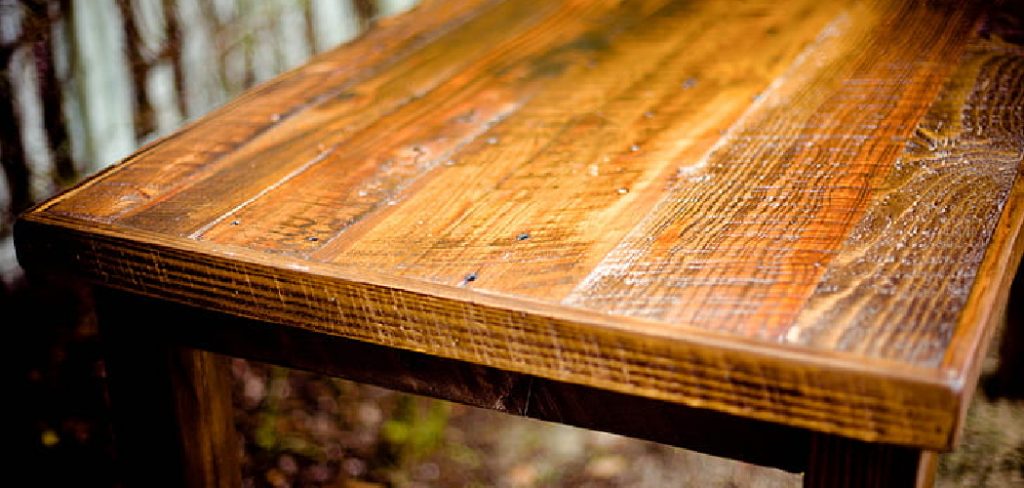
In this guide on how to clean mango wood, we will discuss the best practices for keeping your mango wood items looking their best through simple, effective cleaning methods. Whether you have a mango wood dining table, a set of chairs, or decorative items, this guide will help you care for them in a way that enhances their natural beauty while ensuring longevity.
What is Mango Wood?
Mango wood is a hard, dense, and strong hardwood that is derived from the mango tree. This tree is native to South Asia and Southeast Asia, where it is widely grown for its fruit as well as its wood. Once the mango tree stops producing fruit, it is cut down to make way for new trees, making it an eco-friendly source of wood.
The color of mango wood can range from light brown to dark reddish-brown, with unique grain patterns that add to its aesthetic appeal. Its strength and durability make it an ideal material for furniture, flooring, and decorative items.
Understanding the Cleaning Process
Before we dive into the specifics of cleaning mango wood, it is important to understand the basic principles behind keeping any wood item clean and well-maintained. Wood is a porous material, meaning it can absorb moisture, dirt, and stains if not properly cared for. This can lead to discoloration, warping, and other damage over time. The key to cleaning mango wood is to use gentle methods that do not harm the wood’s natural finish or texture.
You should also keep in mind that mango wood, like any other wood, is susceptible to damage from excessive heat and moisture. Avoid placing it near direct sunlight or sources of heat, and make sure to wipe up spills immediately to prevent water damage. Regular dusting and occasional polishing are also important steps in maintaining the beauty of your mango wood items.
Why Cleaning Mango Wood is Important?
Proper cleaning of mango wood not only keeps it looking beautiful but also ensures its longevity. Regular maintenance can prevent the build-up of dirt and grime that can cause scratches and other damage to the delicate surface of the wood. The natural oils present in mango wood can also dry out over time, and regular cleaning with appropriate products can help restore its luster.
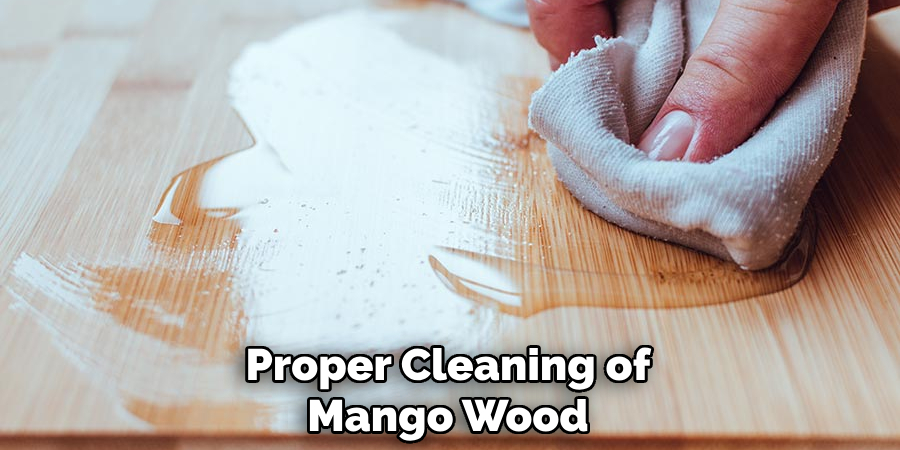
Moreover, by taking care of your mango wood items, you are also contributing to the environment. As mentioned earlier, mango wood is a sustainable source of wood, and by prolonging the life of your items, you are reducing the need for new trees to be cut down.
Needed Materials
To properly clean mango wood, you will need a few simple materials that are gentle on the wood’s surface. These include:
Microfiber Cloth or Soft Cotton Cloth:
These cloths are non-abrasive and ideal for dusting and cleaning delicate surfaces like mango wood.
Mild Soap or Wood Cleaner:
Look for a gentle soap or specialized wood cleaner that is suitable for use on hardwoods. Avoid using harsh chemicals, as they can damage the natural finish of your mango wood items.
Water:
Warm water works best for cleaning mango wood. Make sure to use a small amount and avoid soaking the wood, as excessive moisture can cause damage.
Natural Oils:
To restore the natural oils in your mango wood items, you can use olive oil or coconut oil. These oils will not only add shine but also nourish the wood and protect it from drying out.
11 Step-by-step Guidelines on How to Clean Mango Wood
Step 1: Prepare the Area
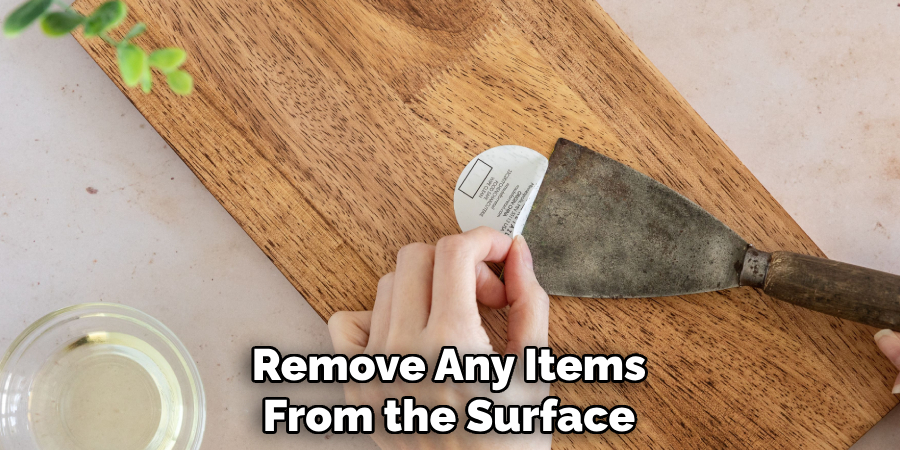
Before you start cleaning, make sure to remove any items from the surface of your mango wood item and clear the area around it. This will prevent any accidents or damage to other objects during the cleaning process. The last thing you want is to accidentally knock over a vase or glass on your prized mango wood table. You should also ensure proper ventilation in the room. It is recommended that mango wood be cleaned in a well-ventilated area to avoid inhaling any fumes from cleaning products.
Step 2: Dust the Surface
Using a microfiber cloth or soft cotton cloth, gently remove any dust and debris from the surface of your mango wood item. Make sure to wipe in the direction of the wood grain to avoid scratching. Otherwise, the dust particles may create scratches on the surface of your wood. It is important to dust regularly to prevent build-up that can cause damage over time. You can also use a small, soft-bristled brush to get into crevices and hard-to-reach areas.
Step 3: Mix the Cleaning Solution
In a small bowl or bucket, mix a few drops of mild soap or wood cleaner with warm water. Make sure not to use too much soap, as it may leave a residue on your wood surface. But if you have tough stains or grease, you can add a bit more soap to the mixture. The key is to use a gentle cleaning solution that will not strip the wood’s natural oils. It is always recommended to test the solution on a small, inconspicuous area before proceeding with cleaning the entire surface.
Step 4: Test on a Small Area
Before jumping into cleaning the entire surface, it is always a good idea to test the cleaning solution on a small, inconspicuous area of your mango wood item. This will ensure that the soap does not cause any damage or discoloration to the wood. If you notice any adverse effects, try a different cleaning solution or seek professional help. You can also check with the manufacturer for recommendations on cleaning agents.

Step 5: Dip Cloth in Cleaning Solution
Once you have tested the solution and are satisfied, dip your cloth into the mixture and wring out any excess water. Make sure the cloth is damp, not soaking wet. Too much moisture can cause damage to wood, so it is important to be mindful of this while cleaning. But at the same time, you do not want to use a dry cloth as it can create scratches on the surface. The ideal dampness level of the cloth is when you squeeze it, and just a few drops of water come out.
Step 6: Wipe in the Direction of the Grain
Using your damp cloth, gently wipe the surface of your mango wood item in the direction of the grain. The grain refers to the natural pattern on the wood’s surface created by its growth rings. This will help avoid any scratches and ensure a thorough cleaning. The damp cloth will help remove any build-up of dirt and grime without damaging the wood’s natural finish. You can also use a soft-bristled brush for hard-to-reach areas.
Step 7: Pay Attention to Crevices
Mango wood items often have intricate designs and crevices that may be difficult to clean. Use a small, soft-bristled brush dipped in the cleaning solution to gently clean these areas. This will help remove any dirt or grime that has built up in these hard-to-reach spots. But make sure to be gentle, as harsh scrubbing can damage the delicate wood. The brush will also help get into the grains of the wood, ensuring a thorough clean.
Step 8: Rinse Cloth and Wipe Again
Periodically rinse your cloth in clean water to remove any dirt or residue that may have accumulated. This will ensure that you are not spreading dirt around while cleaning. Make sure to wring out any excess water so that the cloth is damp and not wet. Use the damp cloth to wipe the surface again, making sure to wipe in the direction of the grain.
Step 9: Dry with Soft Cloth
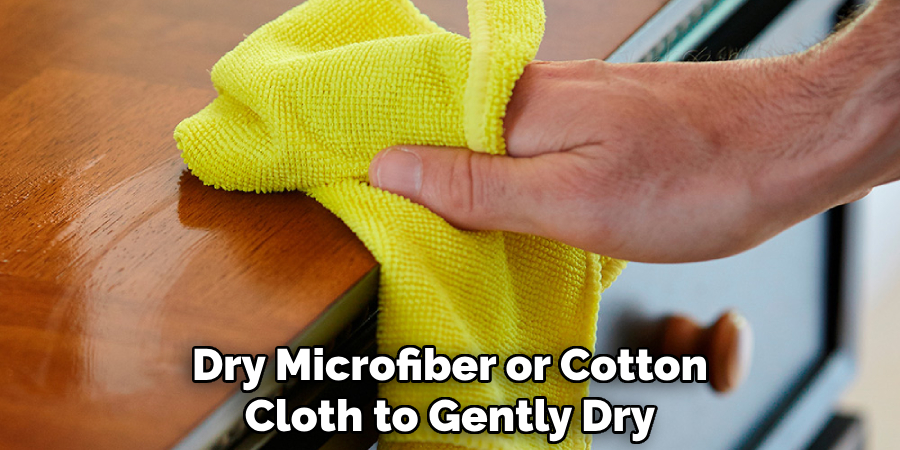
After wiping with a damp cloth, use a clean, dry microfiber or cotton cloth to gently dry the surface. Make sure there is no moisture left on the wood’s surface, as it can cause damage over time. Use a gentle, patting motion to dry instead of rubbing, as this can create scratches or leave streaks. It is important to dry the surface thoroughly, especially in humid environments where moisture can cause damage.
Step 10: Apply Natural Oils
To restore the natural oils in your mango wood items and add shine, you can apply olive oil or coconut oil. Dip a clean cloth into the oil and gently rub it onto the surface of the wood in a circular motion. Make sure not to use too much oil, as it can create a greasy residue on the surface. Wipe off any excess oil with a clean cloth. This step is optional but recommended for maintaining the wood’s natural beauty.
Step 11: Polish (Optional)
If you want to give your mango wood item an extra shine, you can use a wood polish specifically designed for mango wood. Spray the polish onto a clean cloth and gently rub it onto the surface of the wood in a circular motion. Make sure to follow the instructions on the polish bottle and use it sparingly. Too much polish can leave residue or build up on your wood’s surface, causing damage over time.
Following these steps on how to clean mango wood will help ensure that your mango wood items are clean and well-maintained, preserving their natural beauty for years to come. Regular cleaning and proper care will also prevent any potential damage or issues with your beloved mango wood pieces. So remember to dust regularly, use gentle cleaning solutions, and be mindful of moisture levels while cleaning.
Do You Need to Use Professionals?
In most cases, cleaning mango wood can be done safely and effectively at home using the above steps. However, if you have a valuable or antique piece of mango wood that requires special attention, it is best to seek professional help. A professional cleaner will have the experience and knowledge to properly clean and care for your precious item without causing any damage.

They may also use specialized equipment or techniques to ensure a thorough cleaning without compromising the wood’s integrity. So, if you have any doubts or concerns, it is always better to be safe than sorry and call in the experts for help. Additionally, if you are unsure about a certain cleaning product or technique, it is best to consult with a professional before proceeding.
They can provide valuable advice on how to properly clean and maintain your mango wood items. With proper care and maintenance, your mango wood pieces can last for generations, adding a touch of natural beauty to your home decor. So take the time to clean and care for them regularly, and you will enjoy their warmth and charm for years to come.
Preventive Maintenance Tips
- Dust your mango wood items regularly with a soft, dry cloth to prevent the build-up of dirt and grime.
- Use coasters or placemats when placing hot or cold items on the wood’s surface to avoid damage from heat or moisture.
- Avoid using harsh chemicals or abrasive cleaners on mango wood as they can cause damage.
- Keep your mango wood pieces away from direct sunlight to prevent fading or warping.
- If you spill any liquids on the wood’s surface, make sure to wipe them up immediately to avoid staining.
- Regularly apply natural oils or wax to maintain the wood’s natural shine and moisture levels.
- Keep an eye out for any cracks or damage in the wood and address them promptly to prevent further damage.
- Consider rotating your mango wood items to ensure even exposure to light and moisture. Following these preventive maintenance tips will help keep your mango wood items in top condition, ensuring their longevity and beauty. With proper care, you can enjoy the warmth and natural charm of mango wood for years to come.
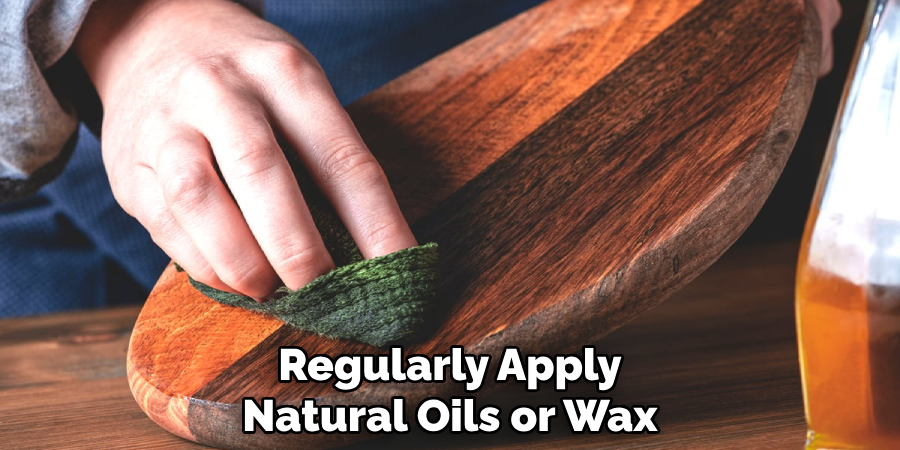
Frequently Asked Questions
Q: Can I Use Any Type of Soap to Clean Mango Wood?
A: A mild soap or wood cleaner specifically designed for wood surfaces is recommended. Avoid using harsh chemicals or bleach, as they can damage the wood’s natural finish. You can also use a natural, gentle soap like Castile soap as an alternative. The key is to use a gentle cleaning solution that will not strip the wood’s natural oils.
Q: How Often Should I Clean My Mango Wood Items?
A: It is recommended to dust your mango wood items regularly and clean them when they appear dirty or have visible build-up. For high-traffic items like dining tables, it may be necessary to clean them more often. But in general, a deep clean every few months should suffice. You can also spot clean as needed in between deep cleans.
Q: Is It Necessary to Apply Oils or Polish?
A: No, it is not necessary to regularly apply oils or polish to your mango wood items. However, it can help restore the natural shine and nourish the wood’s surface. This step is optional but recommended as a way to maintain the beauty of your mango wood items. It is important not to use too much oil or polish, as it can create a greasy residue on the surface.
Q: Can I Use Vinegar to Clean Mango Wood?
A: It is not recommended to use vinegar on mango wood, as it has acidic properties that can damage the wood’s natural finish over time. Stick to using mild soap or wood cleaners specifically designed for wood surfaces. You can also use natural alternatives like Castile soap or vinegar and water solution for spot cleaning. However, regular use of vinegar is not recommended for mango wood items.
Q: Are There Any Special Care Instructions for Mango Wood?
A: In addition to regular dusting and cleaning, it is important to avoid placing hot items directly on mango wood surfaces, as this can cause damage. It is also recommended to use coasters or placemats under glasses and dishes to prevent scratches and water rings. Lastly, avoid placing mango wood items in direct sunlight or near heat sources, as this can cause the wood to dry out and potentially crack.

So make sure to follow these simple care instructions to keep your mango wood items looking beautiful for years to come. Keep in mind that proper care and maintenance will help prolong the life of your mango wood items, allowing you to enjoy their natural beauty for many years to come.
Conclusion
Mango wood is a beautiful and sustainable material that is becoming increasingly popular in furniture and home décor. Properly cleaning your mango wood items is crucial to maintain their appearance and durability. By following the tips and techniques discussed in this guide on how to clean mango wood, you can easily clean and care for your mango wood items, ensuring they remain looking their best for years to come.
Remember to always use gentle cleaning methods and avoid harsh chemicals to preserve the natural beauty of your mango wood. With regular care and maintenance, your mango wood items will continue to bring warmth and charm to your home for a long time. So go ahead and enjoy the unique beauty of this eco-friendly and versatile material in your living space!
About the Author
Adrian Green, a lifelong woodworking enthusiast, shares his passion for the craft through The Woodenify Blog. With a foundation built on years of hands-on experience in his father’s woodworking shop, Adrian is dedicated to helping others learn and grow in the world of DIY woodworking. His approach to woodworking combines creativity, practicality, and a deep appreciation for the art of building with your own hands. Through his blog, he inspires individuals of all skill levels to embark on their own woodworking journeys, creating beautiful, functional pieces of furniture and décor.
Professional Focus
- Specializes in DIY woodworking projects, from furniture to home décor.
- Provides step-by-step guides and practical tutorials for woodworkers of all skill levels.
- Dedicated to helping readers build confidence and skill through easy-to-follow instructions and tips.
- Passionate about fostering a community of makers who can share, learn, and grow together.
Education History
- University of Craft and Design – Bachelor of Fine Arts (BFA) in Woodworking and Furniture Design
- Woodworking Apprenticeships – Extensive hands-on training with skilled craftsmen to refine carpentry and furniture making techniques.
- Online Courses & Masterclasses – Continued education in advanced woodworking techniques, design principles, and specialized tools
Expertise:
- DIY woodworking, carpentry, furniture making, and home décor projects.
- Creating accessible tutorials and guides for beginner to advanced woodworkers.
- Sharing the joys and satisfaction of woodworking, from raw materials to finished products.
